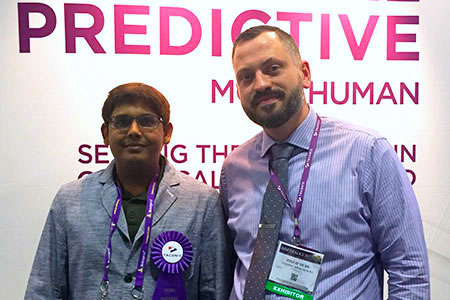
Taconic AAI 2017 travel grant awardee, Trivendra Tripathi (left) and
Taconic Field Applications Scientist, Philip Dubé
Exploration of Novel Target Awarded AAI Travel Grant
Dr. Tripathi presented work using a mouse model of GvHD to study the effectiveness and mechanism of action of a novel anti-OX40L antibody (αOX40L).OX40L (TNFSF4) is a member of the tumor necrosis factor (TNF) superfamily which is expressed on a variety of antigen presenting cells. OX40L binds to its cognate receptor (OX40) on activated T cells, promotes the expansion and survival of effector T cells, and is believed to contribute to GvHD pathology.
What is Graft vs. Host Disease?
GvHD is a major complication in solid organ and bone marrow transplantation, in which donor immune cells attack the recipient's body and damage numerous organ systems. Severe GvHD typically requires intensive immunosuppression, which may render patients susceptible to fatal infections. Targeting only select proinflammatory molecules involved in GvHD may provide a more effective and safer therapeutic intervention for GvHD.Modeling Graft-versus-Host in Immunodeficient Mice
Dr. Tripathi modeled GvHD using super immunodeficient NOG mice injected with adult human immune cells (peripheral blood mononuclear cells). These mature immune cells respond to mouse antigens and cause disease resembling GvHD over time. Importantly, since the immune cells driving this disease are human, this model can be used with antibodies directed against human targets.Dr. Tripathi showed that αOX40L decreased weight loss and mortality when used either prophylactically or following the onset of disease, and that this was associated with an inhibition of CD8+ T cell expansion.
Blocking OX40L was also more effective than targeting either TNF and/or interleukin 21.
Together, Dr. Tripathi's findings show that therapies targeting OX40L may be beneficial in GvHD, and support further clinical development for this strategy.
















.jpg)

.jpg)
.jpg)
.jpg)
.jpg)





.jpg)


.jpg)
.jpg)




.jpg)




.jpg)

.jpg)




